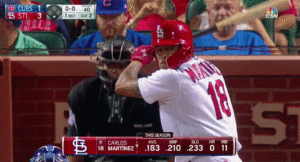
How Willson Contreras Can Improve on Below-Average Framing Numbers
Everything about that magical World Series season was historic for the Cubs. They had an elite defense, the best ERA by a wide margin, and a top-three catching tandem by framing. Their run-prevention unit was among the best all-time, and they had the most efficient defense in MLB history when it comes to balls in play. When looking at the differences between the last year and 2016, pitch framing is something that stuck out.
The trio of David Ross, Miguel Montero, and Willson Contreras combined for 23.8 framing runs (a Baseball Prospectus metric that measures framing chances combined with called strikes above average) in 2016. All three finished among the top 20 defensive catchers, even sharing the workload. Statcorner, which has its own framing metric, agreed with the Baseball Prospectus rankings.
This was very promising for Contreras in particular, since he was converted to catcher relatively recently and is still learning the finer details of the position. Combining his bat with plus defensive skills would put him in the elite tier for catchers.
But year-to-year pitch-framing is fickle in nature, as Jeff Sullivan described wonderfully for FanGraphs, and Contreras’ numbers were much worse last year. Both BP and Statcorner had him as a below-average framer, and both of them had him in the bottom 15 in that category last season. In total, the quartet of Contreras, Alex Avila, Victor Caratini, and Rene Rivera accounted for -10.3 framing runs.
That means nothing without context, but even without much background on the subject you can see that the Cubs’ sub-par pitch framing last season was around 10 runs fewer than it should have been. If we use the framework where 9-10 runs equals one win, framing added over two wins for the Cubs in 2016 a cost them about one win last season.
The case that perhaps best exemplifies Contreras’s poor framing is in late September when both he and John Lackey got ejected for it. Yes, there was a mix-up between the pitches that caused it, but the stab across his body really hurt Contreras.
Below, you’ll find GIFs (click thumbnail to activate) of four other instances from August and September in which Contreras didn’t get the call on pitches that should have been strikes .

Contreras was lining up for a high, inside fastball, but Kyle Hendricks missed his spot and threw Paul DeJong a fastball over the heart of the plate. Although it only registered at 88 mph, Contreras still stabs his left arm across the plate and his glove even leaves the strike zone for a brief period of time. Although Hendricks missed his spot, the aggressive stab made the pitch seem outside when it wasn’t.

Contreras was calling for a curveball and had his glove set up a little lower than the result of the pitch. Still, Hendricks hit his spot and the only thing I see here is that Contreras catches the ball in the middle of his glove and for a split-second carries the ball to the outside of the plate before bringing it back to center.

This is the game that resulted in Wade Davis’s first blown save as a Cub, and it should be noted that his control was off. Contreras is calling for a cutter on the inside corner, but Davis catches the outer third of the plate with the pitch. Belt high, this is clearly not what Davis was aiming for. However, Eric Sogard doesn’t swing and Contreras moves his arm quickly to catch the pitch, holding the same positioning of the glove. Perhaps if he had changed the angle of his glove it would have shown to the umpire that his mitt was in the strike zone.

Another game against the Cardinals, another example of Contreras stabbing his arm to catch a fastball after a pitcher misses his spot. Again, the momentum in Contreras’s arm causes the glove to go outside the strike zone momentarily, resulting in a ball.
In four of the five instances we’ve reviewed, the pitchers either missed their spots or there was a mix-up in signals. But if there’s something I want to see Contreras improve upon for next season it would be that stab across the plate. Elite framers like Buster Posey, Yasmani Grandal and even Jonathon Lucroy, Russell Martin, and Yadier Molina, all tend to be able to stop their gloves from crossing the boundaries of the strike zone on errant pitches.
Coming into next season, I hope to see Contreras getting more of these errant pitches called for strikes. In addition to that, I’d prefer the Cubs go with a defense-first backup to supplement Contreras and/or Caratini rather than a bat-first guy like Avila. Not only is that valuable in its own right, but it would also allow the younger backstops to better hone their craft.

